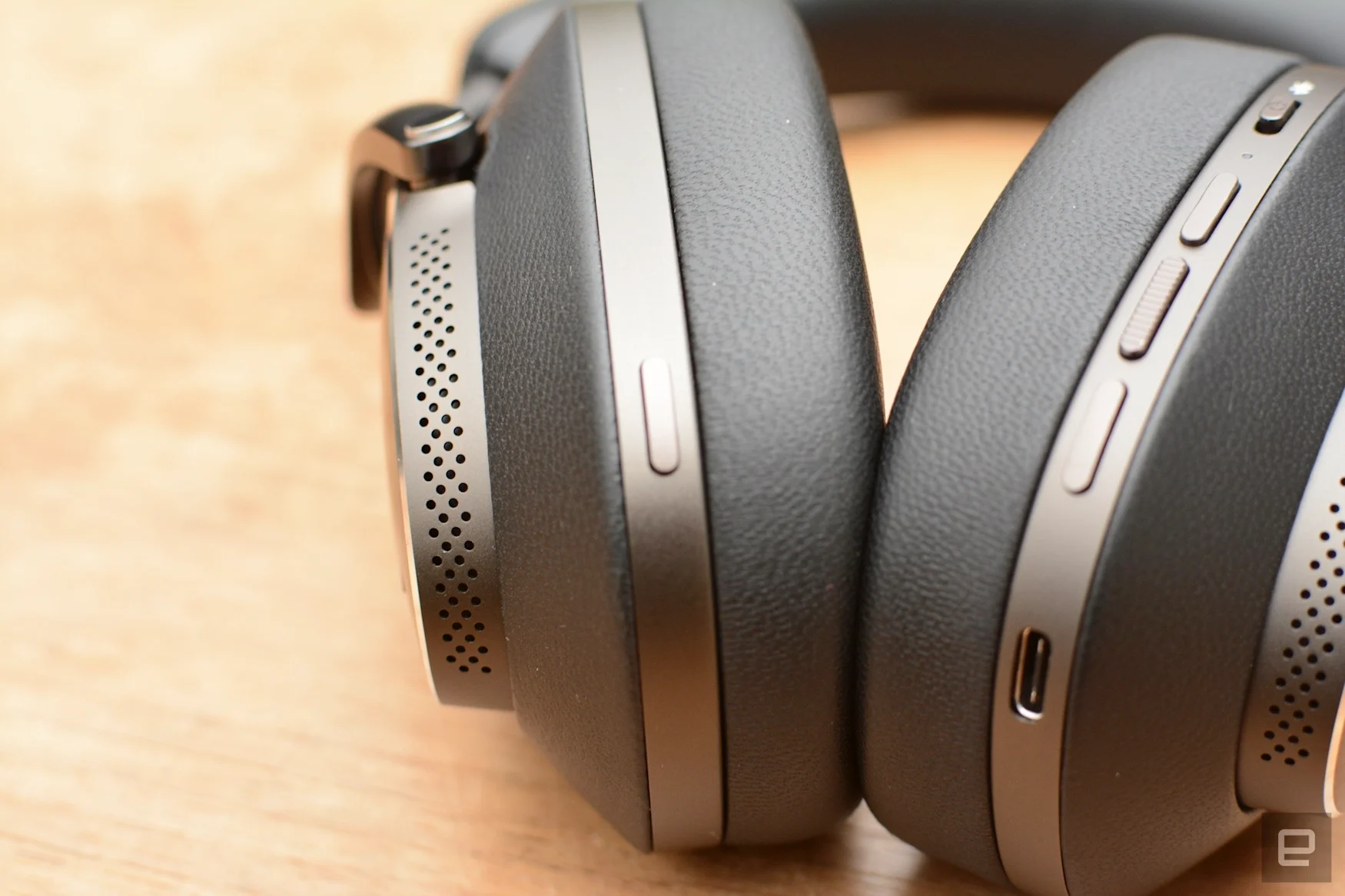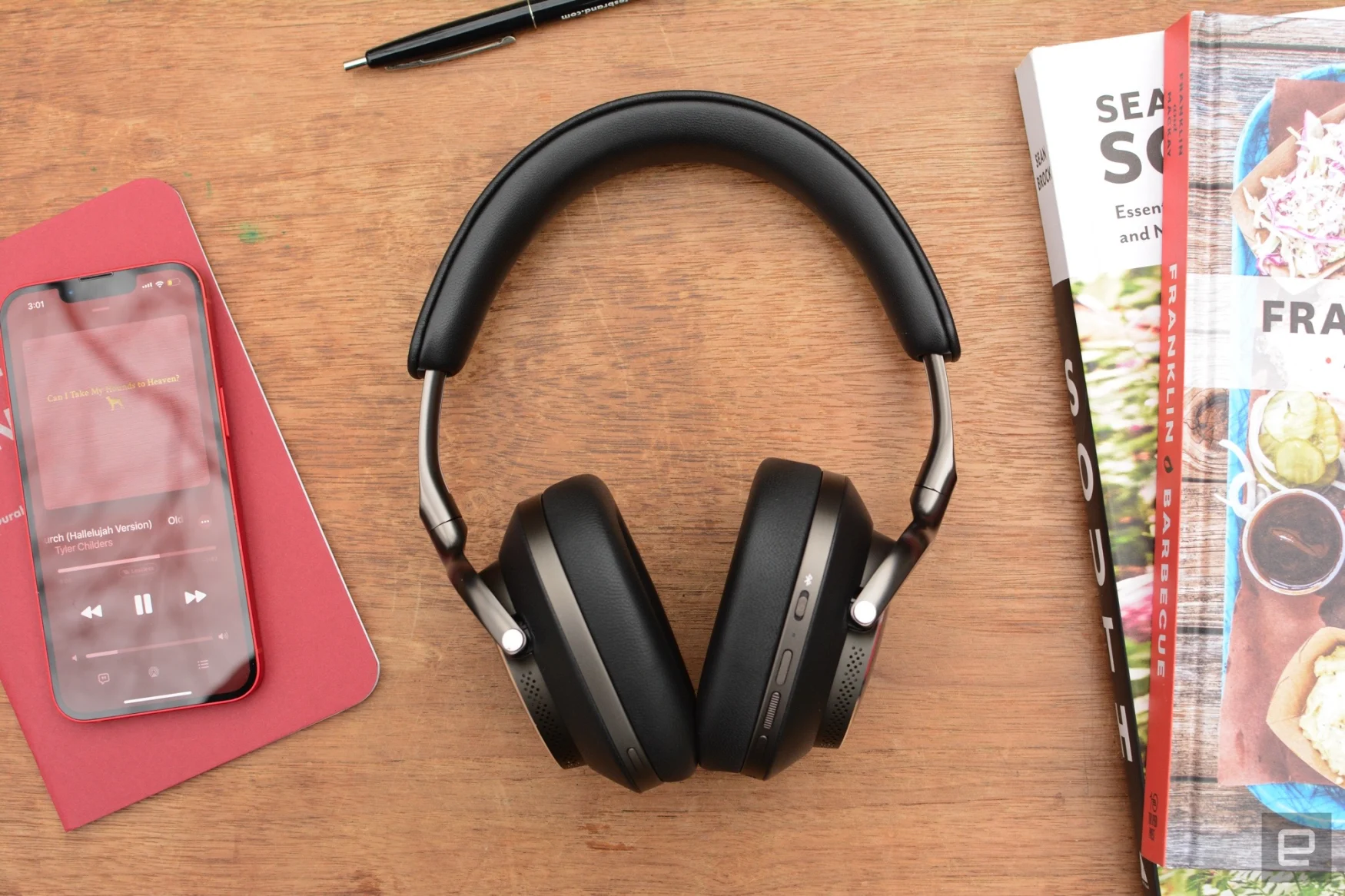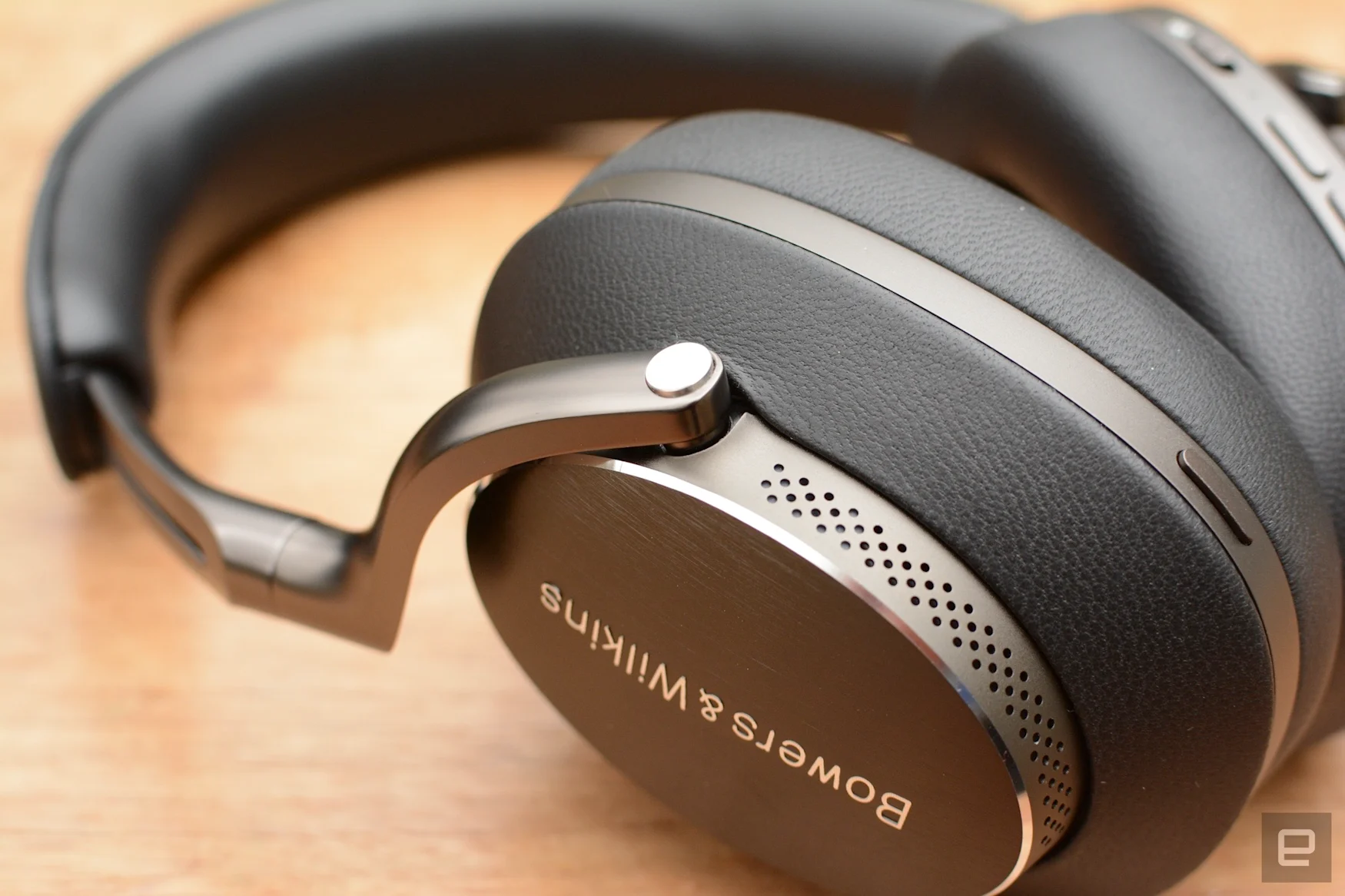Bowers & Wilkins Px8 review: Incredible sound comes at a cost | Engadget
When Bowers & Wilkins announced its Px7 S2 headphones last year, the company made it clear that it already had a more premium offering nearly ready for prime time. Three months later, the Px8 arrived. While the Px8 carries a similar look to its predecessor, Bowers & Wilkins crafted this set of headphones out of more luxurious materials and managed to improve what was already great sound quality. However, the upgrades come at a steep price: the $699 Px8 is $300 more than the Px7 S2.
Design
At a glance, the Px8 looks nearly identical to the Px7 S2 Bowers & Wilkins debuted last year. Upon close inspection though, the differences become apparent. The Px8 has a slightly more refined aesthetic, with soft leather replacing the woven fabric on the outside of the headband and ear cups. The outermost panels of the earcups, where the company’s wordmark resides, is now metal instead of plastic. And the arms and headband slider are cast aluminum, further complementing the more premium design.

Pros
- Excellent battery life
- Pristine sound
- Solid ANC
- Refined design
Cons
- Expensive
- Not as comfortable as the Px7 S2
- Automatic pausing still needs work
The Px8 weighs 13 grams more than the Px7 S2, which is probably (at least partially) due to the change in materials. Memory foam ear cushions keep things comfy, but you can feel the extra load if you’re doing a side-by-side comparison. For that reason, I give a slight edge to the S2 if you need something to wear for several hours at a time. After a Vegas to Atlanta flight this month, I was starting to feel the added weight – and also the rings around the ear cups.
On-board controls are still physical buttons on the Px8, and they’re in the exact same locations as the Px7 S2. On the right, a power/pairing slider sits above a trio of buttons for volume, playback and calls. Over on the left side, a single control toggles between active noise cancellation (ANC), transparency mode and both off. While some companies have nixed buttons in favor of touch panels, those aren’t always reliable, but what Bowers & Wilkins offers here certainly gets the job done.
Software

Billy Steele/Engadget
The Bowers & Wilkins Music app gives you access to all of the settings on the Px8, just like it has for the company’s previous headphones. On the main screen, there’s up-to-date battery status with noise mode selection just below (ANC, Pass-through and off). You can also manage connections here as the Px8 supports multipoint Bluetooth with two devices. Lastly, the company has put media controls (if you link compatible services), tone settings, a quick start guide and product support right on that first panel.
Once you dive deeper into the settings section, battery life percentage and noise mode (or Environmental Control as the company calls it) are prominently displayed once more. Treble and bass sliders are there as well, allowing for very basic EQ tweaks. The company hasn’t provided any presets here, so you’re left with those two variables to adjust. The ability to manage connections is repeated here as well, just above the option to reassign the Quick Action button on the left earcup. By default, it cycles between sound modes. However, if you prefer, you can make it summon a voice assistant.
The last two notable items have to do with power management. First, Bowers & WIlkins offers an automatic standby feature that activates a low power state after 15 minutes of inactivity. You can switch it off if you’d like. The second tool is the ability to activate or disable the wear sensor for automatic pausing. The company says this should pause music when you lift one earcup, but that isn’t always the case. Bowers & Wilkins gives you three sensitivity options to help fine-tune it (low, medium and high), but none of those remedy the fact that the Px8 – like the Px7 S2 – is slow to pause when you lift an ear cup or take them off your head. This could still use some work so that at the very least audio resumes quicker after a break.
Sound quality

Billy Steele/Engadget
One key area the Px8 differs from the Px7 S2 is sound quality. Where the latter packs in a pair of 40mm bio cellulose drivers, the former is equipped with two carbon units of the same size. I’ll admit I don’t know enough about headphone construction to tell you if one is technically better than the other, but what I do know is that the Px8 sounds incredible. The Px7 S2 already had great audio quality, but Bowers & Wilkins somehow manages to take things a step further with this model.
There’s a warmth to the sound profile that invites you to sit and listen a while, no matter the genre. An almost extreme clarity to the audio keeps the most chaotic metal perfectly organized, allowing you to pick out individual instruments. And in the case of Underoath’s Voyuerist, it’s easy to distinguish the backing synth even when it’s very subtle or laid underneath the full band going flat out. The amount of detail the Px8 exudes from bluegrass and jazz tracks is staggering, making it seem like you’re in the room with Béla Fleck as he recorded My Bluegrass Heart. It’s not just banjo, guitar, bass, mandolin and fiddle. You can hear the nuance in the sound of each one as they envelope you.
Gallery: Bowers & Wilkins Px8 headphones review | 12 Photos
Gallery: Bowers & Wilkins Px8 headphones review | 12 Photos
And it’s more than the clarity and detail. The Px8 is a well-tuned powerhouse for bass-heavy electronic music and hip-hop too. When a track demands it, these headphones tap into a stash of low-end that rivals some of the best. And like everything else, you can hear the subtlety in the kick drum, drum machine and bass line. That’s true across the board, whether it’s bombastic beats of RTJ4 or the intricate synth work on Sylvan Esso’s No Rules Sandy.
In terms of active noise cancellation, the Px8 does an admirable job. It’s not miles better than the Px7 S2, but in nearly every circumstance – including on an airplane – these headphones are up to the task. Bose and Sony manage to block out more on the QuietComfort 45 and the WH-1000XM5 respectively, but Bowers & Wilkins didn’t phone it in here. There’s some solid ANC performance, it’s just not the absolute best.
Call quality
Bowers & Wilkins says it moved two of the six on-board microphones closer together and re-angled them to improve voice quality. The company explained that these tweaks should also reduce wind noise. Call audio for the person on the other end was already good on the Px7 S2, but the lack of a natural-sounding transparency mode made me feel a bit shouty during voice and video chats. On the Px8, that pass-through audio is still good, but not great, and not as natural sounding as the AirPods Max.
The Px8 does a great job of cutting down on background noise, though, so the headphones will help whoever is on the other end focus on your voice. However, overall voice quality isn’t great as you’ll still sound like you’re on speaker phone rather than having a decent mic near your face. Are they fine for most video and voice calls? Sure. If you’re doing those things often should you consider these as your primary tool? Probably not.
Battery life

Billy Steele/Engadget
Bowers & Wilkins has a track record of under promising and over delivering when it comes to battery life on its headphones. The company consistently outperforms the stated figure by a mile and the same is true on the Px8. Much like the Px7 S2, this model still had 40 percent left in the tank at the 30-hour mark – the company’s official rating. And yes, that’s with active noise cancellation turned on over the course of a few days, plus the occasional use of transparency mode for calls. After 30 hours on the Px7 S2, there was 33 percent left, so the Px8 seems to be slightly more efficient than its more affordable sibling – or perhaps has a slightly bigger battery.
The company has included a quick-charge feature that gives you seven hours of listening time in 15 minutes. That’s nice if you find yourself in a pinch, but with well over 30 hours of ANC use available, I’m only charging once a week after using the Px8 a few hours each day. The battery life here stacks up well against the best you can get in noise-canceling headphones right now.
The competition
At $699, the Px8 is the most expensive set of wireless noise-canceling headphones I’ve reviewed. Even Master & Dynamic’s priciest model is $100 cheaper (the MW75). You have to really dig what Bowers & Wilkins is putting down to dive in here. Simply put, there are great alternatives available for less – some of which offer more features. Heck, I’d argue the company’s own Px7 S2 is a better value at $399.
The Px7 S2 may not have the high-end look of the Px8, but it does have excellent sound quality, solid ANC performance and better-than-advertised battery life. The company’s warm, crisp and clear audio is on display on the more affordable model and it’s more comfortable to wear for long periods of time. Aside from the boost in overall sound quality and that refined design, the Px7 S2 has every other feature you get on the Px8 – for a lot less.
At this point, Sony’s WH-1000XM5 is still the best you can buy, mostly for the mix of audio and noise-canceling performance, with a long list of handy features on the side. The two most notable are the M5’s ability to automatically change sound modes based on your location or activity and the Speak-to-Chat tool that pauses the audio when you begin to speak. Simply put, no other company comes close to packing in as much as Sony.
Wrap-up
When a pair of headphones costs $699, I start to expect things. Mainly that they need to be damn near perfect for me to recommend them. The Px8 nearly is when it comes to sound quality, but there are other areas where they fall short of the company’s previous model and some of the competition. Automatic pausing is still in need of refinement, even with the sensitivity settings. And overall, the Px7 S2 is much more comfortable to wear for long periods of time. Bowers & Wilkins impresses with this most premium offering, but there are still some rough edges to smooth out.
All products recommended by Engadget are selected by our editorial team, independent of our parent company. Some of our stories include affiliate links. If you buy something through one of these links, we may earn an affiliate commission. All prices are correct at the time of publishing.
For all the latest Technology News Click Here
For the latest news and updates, follow us on Google News.

